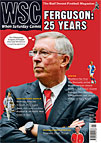 Taking their lead from the Bundesliga, Celtic fans are campaigning for the return of standing areas, reports Mark Poole
Taking their lead from the Bundesliga, Celtic fans are campaigning for the return of standing areas, reports Mark Poole
Terracing could soon be returning to top-flight British football. Celtic are conducting a feasibility study into installing safe standing areas at Celtic Park, following a proposal from the Celtic supporters’ trust. The board seem well disposed to the proposal and Neil Doncaster, the Scottish Premier League chief executive, says it is an option he “would like to see explored”. Unlike in England and Wales, Scottish law doesn’t prohibit terracing, but SPL and SFA rules would have to change before any top-flight clubs could bring back standing areas.
For domestic games at least, the once famous atmosphere at Celtic Park mellowed after the stadium was renovated and modernised in the 1990s and fans grew used to success under Martin O’Neill. The Green Brigade ultra-style fan group has brought back some atmosphere and the supporters’ trust view terracing as a way of making match days even more effusive. Most fans agree that terracing generates more atmosphere than seated areas. A YouTube search for Borussia Dortmund’s famous Südtribüne provides clear evidence of how impressive modern terraces can be.
The atmosphere that the Green Brigade generate is seen as controversial and accusations of pro-IRA chanting have been levelled at some Celtic fans recently. Celtic will have to convince their fellow clubs and the governing bodies that a standing area wouldn’t affect their ability to identify any fans guilty of offensive chanting. If they can, it is hard to see why anyone in Scotland would vote against allowing the return of terracing, given the evidence of how safe modern standing areas are.
Leading football stadium architect John Barrow recently told the International Football Arena conference: “In terms of safety, [terracing] can be done without any problems at all in small areas.” Germany’s famously successful safe standing areas usually consist of a number of relatively small areas, which incorporate waist-high rails on every second step. This allows fans to circulate but prevents dangerous mass movements. Barrow also emphasised the importance of proper management of standing areas, reflecting the growing acknowledgement that it is not terracing itself that is dangerous, but irresponsible management of those terraces.
Terracing could help ease Scottish football’s financial problems. The Celtic board’s willingness to consider the proposal seriously is evidence of its potential profitability. The Safe Standing Roadshow website estimates that modern German-style terraces have a capacity 80 per cent greater than that of seated areas of the same size. But few games in the SPL currently sell out. Newly promoted Dunfermline closed their north stand recently to save money.
If we assume that terracing ticket prices would be approximately 70 per cent of seat prices, converting part of any ground that doesn’t regularly sell out could be a gamble. Presumably part of the remit of the Celtic board’s feasibility study is to examine whether the improved atmosphere and reduced prices would tempt enough wavering punters along to increase ticket revenue. Rangers will be particularly interested in Celtic’s decision, since their average attendances are currently nearer capacity.
If attendances rise but ticket revenue remains steady, clubs would still benefit from additional “secondary matchday revenue”. More people in the stadium means more people to buy food, drink and club-branded Blackberry covers. If you have paid £18 rather than £26 to watch a goalless draw with Hibs, you will be less reluctant to fork out for that chunky club bracelet you have always wanted but will probably never wear. The argument in favour of safe standing areas that resonates most with fans is that the people who insist on standing in front of you, blocking your view of the game, would be gone – to the standing area.
Celtic fans are not the only people that want to reintroduce standing sections, but they could be the first top-flight British club with terracing since Fulham had to remove theirs ten years ago.
From WSC 299 January 2012